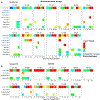Bidirectional transfer of Anelloviridae lineages between graft and host during lung transplantation
- PMID: 30203917
- PMCID: PMC6411461
- DOI: 10.1111/ajt.15116
Bidirectional transfer of Anelloviridae lineages between graft and host during lung transplantation
Abstract
Solid organ transplantation disrupts virus-host relationships, potentially resulting in viral transfer from donor to recipient, reactivation of latent viruses, and new viral infections. Viral transfer, colonization, and reactivation are typically monitored using assays for specific viruses, leaving the behavior of full viral populations (the "virome") understudied. Here we sought to investigate the temporal behavior of viruses from donor lungs and transplant recipients comprehensively. We interrogated the bronchoalveolar lavage and blood viromes during the peritransplant period and 6-16 months posttransplant in 13 donor-recipient pairs using shotgun metagenomic sequencing. Anelloviridae, ubiquitous human commensal viruses, were the most abundant human viruses identified. Herpesviruses, parvoviruses, polyomaviruses, and bacteriophages were also detected. Anelloviridae populations were complex, with some donor organs and hosts harboring multiple contemporaneous lineages. We identified transfer of Anelloviridae lineages from donor organ to recipient serum in 4 of 7 cases that could be queried, and immigration of lineages from recipient serum into the allograft in 6 of 10 such cases. Thus, metagenomic analyses revealed that viral populations move between graft and host in both directions, showing that organ transplantation involves implantation of both the allograft and commensal viral communities.
Keywords: basic (laboratory) research/science; bronchoalveolar lavage (BAL); clinical research/practice; donors and donation: donor-derived infections; infection and infectious agents - viral; infectious disease; lung transplantation/pulmonology; microbiomics.
© 2018 The American Society of Transplantation and the American Society of Transplant Surgeons.
Figures





References
-
- Grossi PA, Fishman JA, of Practice AST. Donor-Derived Infections in Solid Organ Transplant Recipients. American Journal of Transplantation. 2009;9(s4). - PubMed
-
- Peghin M, Hirsch HH, Len Ó, Codina G, Berastegui C, Sáez B, et al. Epidemiology and Immediate Indirect Effects of Respiratory Viruses in Lung Transplant Recipients: A 5-Year Prospective Study. American journal of transplantation : official journal of the American Society of Transplantation and the American Society of Transplant Surgeons. 2017;17(5):1304–12. - PMC - PubMed
-
- Vu DLL, Bridevaux POO, Aubert JDD, Soccal PM, Kaiser L. Respiratory viruses in lung transplant recipients: a critical review and pooled analysis of clinical studies. American journal of transplantation : official journal of the American Society of Transplantation and the American Society of Transplant Surgeons. 2011;11(5):1071–8. - PMC - PubMed
Publication types
MeSH terms
Grants and funding
LinkOut - more resources
Full Text Sources
Other Literature Sources
Medical

